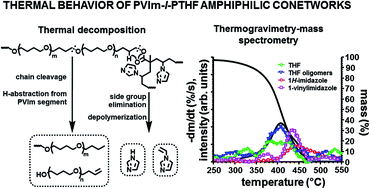Unexpected thermal decomposition behavior of poly(N-vinylimidazole)-l-poly(tetrahydrofuran) amphiphilic conetworks, a class of chemically forced blends†
Abstract
The underlying chemical processes of the unexpected thermal decomposition behavior of poly(N-vinylimidazole)-l-poly(tetrahydrofuran) (PVIm-l-PTHF) amphiphilic conetworks (APCNs) as chemically forced blends of the otherwise immiscible components in broad composition ranges were investigated by thermogravimetric analysis (TG) and thermogravimetry-mass spectrometry (TG-MS). Surprisingly, the thermal decomposition of these conetworks occurs not by an expected two-stage but an apparently single-stage process. The homolytic scission of the PTHF cross-linkers is preceded by a less significant volatile product evolving by a non-radical reaction, presumably related to the well-known cis-elimination of the methacrylate ester linkages. The temperatures of the highest weight loss rate (Td(max)) were found to fall between that of the pure PVIm and PTHF homopolymers, and a universal correlation exists between Td(max) and the composition of the conetworks. The main thermal decomposition reactions of the polymer components in the PVIm-l-PTHF APCNs remain the same as in the corresponding homopolymers. However, among the two main degradation reactions of PVIm, the free radical depolymerization is promoted by PTHF macroradicals of molecular vicinity via hydrogen abstraction, which results in PTHF chains with improved stability. In contrast to expectations, this leads to a single-stage decomposition process of the two chemically interacting polymers in the conetworks. These results are expected to contribute to designing a variety of bi- and multicomponent polymeric materials with predictable thermal behavior composed of chemically and physically interconnected polymer chains, ranging from polymer blends to networks, block copolymers, composites and hybrids of the nanoscale to macroscopic objects.


 Please wait while we load your content...
Please wait while we load your content...